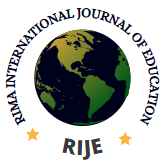Play Facilities as Predictors of Pre-Reading Skills Acquisition among Preschoolers in Chanchaga Local Government Education Area of Niger State
Maryam Musa
Department of Early Child Care Education, Niger State College of Education Minna, Nigeria Email: maryammusaedu@gmail.com
Abstract
The study investigates the play facilities as predictors of pre-reading skills acquisition among preschoolers in Chanchaga Local Government Education Area of Niger State. Two research questions and two null hypotheses guided the study. The study adopted a correlation survey research design. The population of the study is 4087 preschoolers in the 29 early child care centers in all the public primary schools in Chanchaga Local Government Area of Niger state. A sample of 356 preschoolers were used for the study. Play Facilities Questionnaire (PFQ) and Pre-reading Skills Acquisition Rating Scale (PSARS) were used for data collection. The two sets of the instrument were face validated by three experts (Two in Department of Early Childhood and Primary Education and one from Measurement and Evaluation Unit, Department of Science Education all from Faculty of Education University of Nigeria, Nsukka). Internal consistency reliability through Cronbach alpha gave a reliability coefficient for pre-reading rating scale as 0.886. The internal consistency reliability coefficients for the clusters of A and B are given as 0.85, and 0.84 respectively in pe-reading skills. Linear regression analysis was used in answering the research question while t-test associated with linear regression was used in testing the formulated hypotheses at 0.05 level of significance. The finding of the study revealed that play facilities have a high significant predictive power on print motivation skills and print awareness skills of preschoolers in Chanchaga Local Government Education Authority of Niger State. Based on the findings and conclusion, the following recommendations were made, that the school authority should provide pictorial and video games that can increase pupil’s motivation skills. The parents of preschoolers should provide print materials as based on school text listings in order to enhance the acquisition of print awareness skills.
Keywords
Play Facilities, Pre-schoolers, Pre reading skills, Print motivation, Print awareness
Reference
Albuquerque, M., & Martins, L. (2022). Letter-writing skills as predictors of spelling abilities in young learners. Early Literacy Journal, 14 (2), 112-127.
Bayraktar, S. (2018). Investigation of the print awareness skills of preschool children in terms of child and parent variances in Cankaya district of Ankara Province, Turkey. Early Childhood Education Journal, 46(5), 609-618.
Bayraktar,V., & Temel, F. (2017). Yazıfarkındalığıbecerileri. In F. Temel (Ed.), Dilveerkenokuryazarlık(pp. 63-88). Ankara: Hedef CS.
Heilmann, J., Moyle, M., &Rueden, K. (2018). Using alphabet knowledge to track emergent literacy skills among children in Head Start. Journal of Educational Psychology, 110 (5), 631-644. doi:10.1037/edu0000265
Charles, A., Olisaeke, I., Ibiam, E., & Ebizie, C. (2022). The effectiveness of the play-way method in teaching basic science: A comparison with conventional methods. Journal of Science Education, 45 (2), 121-134. https://doi.org/10.1016/j.jse.2022.03.001
Chebutuk, J., & Aiko, S. (2019). The availability of play materials and their influence on children’s acquisition of physical skills in Koibatek Sub-County, Baringo County, Kenya. Journal of Early Childhood Education, 51 (2), 87-100. https://doi.org/10.1007/s10643-019-01055-6
Throne, A. (2020). The impact of letter-based instruction on preschool literacy development. Journal of Early Childhood Education, 48 (1), 23-35. https://doi.org/10.1007/s10643-020-01161-1
Jaluo, W. M. (2021). Teacher Classroom Practices and English Language Reading Readiness of Children in Grade One at Kericho Rehabilitation School, Kenya. Doctoral dissertation, University of Nairobi.
Nicholas, M. & Rouse, E. (2021). Learning to read: where should early childhood educators begin?. Literacy, 55(1), 3-13.
McGeown, S., Bonsall, J. Andries, V Howarth, D & Wilkinson, K (2020). Understanding reading motivation across different text types: Qualitative insights from children. Journal of Research in Reading, 43 (4), 597-608.
Sandhu, R. (2016). What is Reading? – Definition & Process. Retrieved June 2022, from Study.com:https://study.com/academy/lesson/what-is-readingdefinition-process.html
Taylor, Marissa, (2022). An Examination Of Print Awareness When Using Electronic And Printed Books With Preschool-Aged Children. Online Theses and Dissertations. 770.
UNESCO. (2022). Pre-primary education. United Nations Educational, Scientific and Cultural Organization. https://en.unesco.org/themes/early-childhood-care-and-education.
Yılmaz, R., & Saraçoğlu, S. (2022). Effects of the Flipped Classroom Model on Learners’ Reading Strategy Use and Attitudes. Journal of Language Teaching and Learning, 12(2), 118-137.
